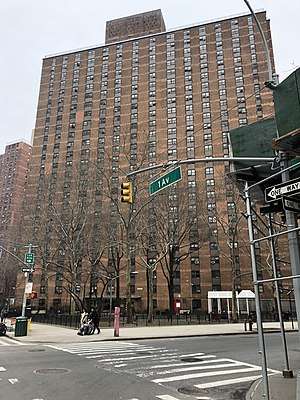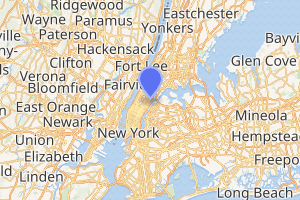Holmes Towers
The John Haynes Holmes Towers is a public housing project for low income residents of the Yorkville section of the Upper East Side located just south of the neighborhood's northern limit at 96th Street, in New York City, New York, United States. The neighboring Isaacs Houses and the Holmes Towers border East Harlem, which has the highest concentration of public housing in the United States. The two public housing buildings, designed by Architects Eggers and Higgins, were completed in 1969, are 25 stories tall and contain 537 apartments. The project is located between 92nd and 93rd Streets from 1st Avenue to York Avenue and the FDR Drive.[3]
Holmes Towers | |
|---|---|
 | |

Location in New York City | |
| Coordinates: 40.781319°N 73.948110°W | |
| Country | United States |
| State | New York |
| City | New York City |
| Borough | Manhattan |
| Area | |
| • Total | 0.004 sq mi (0.01 km2) |
| Population | |
| • Total | 951 [2] |
| ZIP codes | 10128 |
| Area code(s) | 212, 332, 646, and 917 |
| Website | my |
The development was named for the founder of the Community Church of New York. John Haynes Holmes was known as a pacifist, social organizer, and social justice pioneer.[3]
History
As of 1973, the Towers were described as being home to white, elderly residents.[4] 60 percent of the apartments in Holmes Towers are set aside for tenants over the age of 62.
Since June 2006, a greenmarket has operated on 92nd Street and 1st Avenue in front of Holmes Towers.[5][6] It was the first Greenmarket on a NYCHA property.
The Isaacs Houses projects are located just north of the Holmes Towers. Both developments are considered one complex totaling 5 buildings having the same Development Management Office managed by New York City Housing Authority.
Both housing projects, as a whole, have been designated a "high crime zone" by the New York City Police Department's 19th precinct since the early 2000s, and are thus policed to a higher extent, especially due to the heavy socio-economic mixing of the immediate surrounding area, which includes public housing, working-class small tenement buildings, middle-class medium-size buildings, and upper-middle class to upper-class luxury buildings along 1st avenue in the area. Crime, however, is considered to be relatively minimal compared to the projects further north.[7]
In 2015 it was announced that the complex's playground would be razed for a new mixed-use building under New York's NextGen program to help meet the capital needs of NYCHA. It was estimated that the towers would need $47 million in capital repairs over the next five years.[8][9] The 47-story tower was intended to be half affordable housing and half market rate housing with the lower-income tenants on the lower floors. Holmes Towers residents decried the plan, citing the lack of sunlight would lower their quality of life and lacked input in the plans, later staging a protest.[10][11] In order to build the towers, property developer and de Blasio donor Fetner Properties would lease the land from NYCHA for $25 million for 99-years, pocketing all rent, qualifying for $13 million in subsidies, and paying no property taxes.[12] In 2019, Manhattan Borough President Gale Brewer sued Mayor Bill de Blasio and NYCHA to block the new tower. The lawsuit accused of de Blasio of trying to use his power to push the towers through illegally by skirting zoning laws and not having the project go through Uniform Land Use Review Procedure (ULURP).[13] Later that year, NYCHA withdrew its Section 18 land disposition that would allow the building to be built.[14]
In 2018, the Holmes Towers along with Isaacs Houses and Robbins Plaza, which are all run by the same managers, ranked the worst in the nation after federal inspections by the United States Department of Housing and Urban Development.[15]
References
- "Holmes TowersArea". Retrieved November 7, 2019.
- "Holmes Towers Population".
- "MyNYCHA Developments Portal". my.nycha.info. Retrieved July 2, 2019.
- "Widow, 84, Found Stabbed to Death In 92d St. Project". New York Times. February 23, 1973. Retrieved October 3, 2017.
- "92nd Street Greenmarket | GrowNYC". www.grownyc.org. Retrieved July 2, 2019.
- Severson, Kim (July 19, 2006). "Greenmarket at 30, Searching for Itself". The New York Times. ISSN 0362-4331. Retrieved July 2, 2019.
- Crow, Kelly (November 10, 2002). "NEIGHBORHOOD REPORT: UPPER EAST SIDE; With Affluence All Around, A Little Crime Seems a Lot". New York Times. Retrieved October 3, 2017.
- "Some Residents Of UES Housing Complex Worried About NYCHA Development Plans". September 14, 2015. Retrieved July 2, 2019.
- Nahmias, Laura. "NYCHA selects Wyckoff Gardens, Holmes Towers for new development". Politico PRO. Retrieved July 2, 2019.
- Smith, Greg B. "NYCHA plans to stick lower-income residents on bottom floors of new building to give wealthier tenants the top market-rate homes". nydailynews.com. Retrieved July 2, 2019.
- Fitzsimmons, Daniel. "Tenants Protest Housing Plan". www.nypress.com. Retrieved July 2, 2019.
- Smith, Greg B. "EXCLUSIVE: Developer who won NYCHA bid to build apartment tower is big de Blasio donor, records reveal". nydailynews.com. Retrieved July 2, 2019.
- DeGregory, Priscilla (April 19, 2019). "Gale Brewer sues De Blasio, NYCHA to block UES high-rise". New York Post. Retrieved July 2, 2019.
- Chediac, Joyce (June 18, 2019). "NYC public housing victory: 'When we fight, we win!'". Liberation News. Retrieved July 2, 2019.
- Hicks, Nolan; Fenton, Reuven; Golding, Bruce (September 11, 2018). "Feds rank UES housing projects among worst in nation". New York Post. Retrieved July 2, 2019.